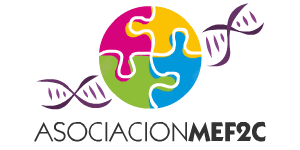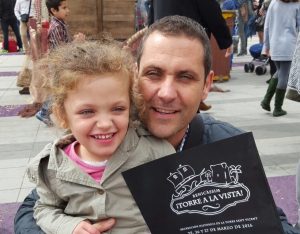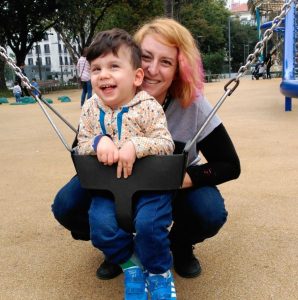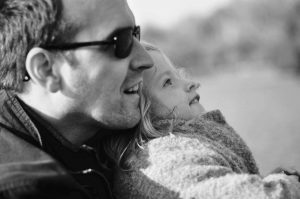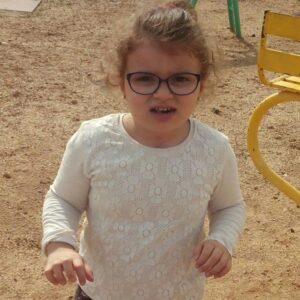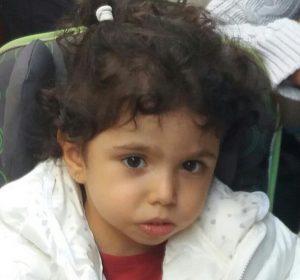Who are its Members?
CELIA
Celia was born on September 9, 2011 in Castellon . She is fraternal twin to Irene and has a baby sister , Martina , who was born in February 2015. They three are very loved girls and the joy of their parents and their entire family.
Being a twin , we soon realized that the development of Celia was not right. Something was not right since she didn´t look, play or smile…
At eight months old she had her first seizure and this triggered everything. Right then , we started two and a half years of tests, frequent visits to hospitals and to different pediatric neurologists. We have to say that, we haven´t been very lucky in medical terms: they have lost some evidence , Celia has received some wrong treatment and many times we have felt lost, without knowing where to go. There is still much to be done in the diagnosis of rare diseases .
 We will not mention here the bad points but the good ones. Thanks to Dr. Herranz from Santander and Dr. Pantoja at the Hospital de la Plana of Vila-real, we got to know the diagnosis.
We will not mention here the bad points but the good ones. Thanks to Dr. Herranz from Santander and Dr. Pantoja at the Hospital de la Plana of Vila-real, we got to know the diagnosis.
Celia has a rare genetic disease , 5q14.3 Microdeletion Syndrome , which in her case affects the MEF2C gene, missing a piece of it. This disease affects her psychomotor development , causing a significant delay with autism spectrum traits and seizures , which in the case of Celia are just febrile.
In Spain we only know another boy affected and in the world there are about 50 or 60 already known cases. Thanks to two Facebook groups, we have met other children and have shared doubts , experiences and treatments. They are our second family .
In the search for answers and learn more about this disease, we found Dr. Stuart Lipton. He has been a ray of hope for us. Suddenly, something which was incurable could get treatment. However, he needs funds to continue their research. This is the main reason why the association is created , to try to raise funds for their research.
 In these four years Celia has attended numerous therapies. Actually, here we have been very lucky and have met wonderful people . She began in early assistance in ASPROPACE (Association of cerebral palsy) , where we were given some guidelines that have helped us understand Celia better and make the best of her. She still attends physiotherapy sessions there. She has also attended hydrotherapy sessions since she was really small in Urban Sport , where Ruben, Rosana and especially Carlos , have been really involved with the girl since the very first moment. This year she has started speech therapy and occupational therapy in Psicotrade , where they got along well with Celia from the beginning. In addition to these therapies , Celia attends CYL (Language and Communication) classroom at Gaeta Huguet school, where she has well settled in, so we are very pleased with the progress of our child.
In these four years Celia has attended numerous therapies. Actually, here we have been very lucky and have met wonderful people . She began in early assistance in ASPROPACE (Association of cerebral palsy) , where we were given some guidelines that have helped us understand Celia better and make the best of her. She still attends physiotherapy sessions there. She has also attended hydrotherapy sessions since she was really small in Urban Sport , where Ruben, Rosana and especially Carlos , have been really involved with the girl since the very first moment. This year she has started speech therapy and occupational therapy in Psicotrade , where they got along well with Celia from the beginning. In addition to these therapies , Celia attends CYL (Language and Communication) classroom at Gaeta Huguet school, where she has well settled in, so we are very pleased with the progress of our child.
The truth is that Celia has given us our greatest concerns, but also our greatest joys such as :
The first time she laughed, 7 months old
The first time she sat down, 13 months old
The first time she crawled, 20 months old
The first time she ate a biscuit by herself, 20 months old
The first time she took a step forward by our hand, 23 months old
The first time she held a fork, 2.5 years old
The first time she drank by herself, 2.5 years old
The first time she walked by herself, 3 years old
The first time she caught a pictogram and gave it to us, 4 years old
We hope to get many more joys from her in the future. Being with her is a struggle with a reward, she helps people next to her focus on what is really important and live everything in a more intense way.
GUILLEM

Guillem was born on December 8, 2012 in Valencia. During pregnancy, his ultrasounds showed some problems: a generalized oedem, which was reabsorbed in week 15 , single umbilical artery and reverse venous ductus, all these being symptoms of Down syndrome, which was ruled out in the amniocentesis. For doctors, these symptoms can also be found in normal fetuses.
Our beautiful Guillem was born , and when he was about 4 months, his pediatrician found that his evolution was not normal and led us to our first pediatric neurologist. Dr. Villar , at the Clinical Hospital of Valencia, had the good sense to ask for a genetic test among the first tests , and then dumb luck : 5q14.3 Microdeletion , covering only half of a gene, the fatal MEF2C . For us it was like the end of the world . His condition in Guillem is severe cognitive and psychomotor retardation , hypotonia , stereotypies , autism, and refractory epilepsy .
Our worst fight has been against fierce epilepsy with seizures day and night, every hour. We looked for a new pediatric neurologist. The types of seizures : myoclonic , atonic , absences, spasms and tonic-clonic seizures with fever. Guillem has gone through a sea of treatments , being all drugs , corticoids and ketogenic unsuccessful. Finally , a new neuropaediatrician found the magical combination , and since September 2015 Guillem has had his crisis controlled.
Until that day mobility had been minimal. At 10-12 months old he could hold and turn his head. But he came to a halt. From the control of epilepsy , his evolution has accelerated . Now , being 3 years old, he can sit down a bit and can sit on his knees alone .
His eyesight is affected, although it is improving. He is able to look at a screen and have fun with it, but he cannot organize well the focus on three dimensions.
Other problems are angiomas on his body ( pink spots ) and small holes between ventricles in his heart.
In his early therapy and since the very first moment we knew his diagnosis, Guillem attended stimulation centers, he also went to the great Red Cross Cerebral Palsy School of Valencia, and previously to the specialized nursery school of AVAPACE (Valencian Aid Association to Cerebral Palsy).
In addition , he attends speech therapy , physiotherapy and occupational therapy, in the Brain Injury Unit of Ntra. Sra. Del Carmen. We have planned both hydrotherapy, which Guillem loves, and Visual Therapy for a close future.
 At home we have a biped-stander and a jumper to strengthen his legs, and insoles DAFO for sleeping . However, he does most of the work on the ground, in our former lounge .
At home we have a biped-stander and a jumper to strengthen his legs, and insoles DAFO for sleeping . However, he does most of the work on the ground, in our former lounge .
Despite his disability, he is a very healthy child, he barely gets a cold and eats and sleeps great.
Guillem´s personality is that of a very sweet and smiling boy who fulfills his family with happiness. Guillem has a brother, Alex, two years older, who is learning to look after him. Today , we are engaged in a great struggle with government to ensure that they are accomplished all Guillem´s rights and those of all the other children with high disability and rare diseases.
Despite being an ultra-rare disease, we have been the luckiest with Dr. Stuart Lipton (San Diego , California) with his study of MEF2C , and progress with tests of several medications, including one capable of stimulating MEF2C second copy of the gene, which our children still have , predicting many improvements. Our main goal now is to find all possible funds to finance the continuity of these studies, so essential for the lives of our children .
LISA
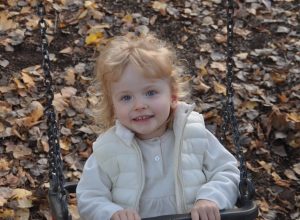
Lisa was born on May 31, 2013 in Brussels (Belgium) . The pregnancy was normal and her birth was a great event for us, as for any family. We were delighted to have a girl because we already had an 8-year-old son.
Everything was fine with Lisa until we realized, when she turned 8-9 months, that she was not evolving like other babies of her age. Having a look at the children of my friends, who were born almost at the same time that my daughter, I noticed Lisa didn´t do the same things as these children (sitting down properly, taking toys with hands , etc ). I explained it to my pediatrician, who told me not to worry. But when Lisa was 12 months, I insisted and then he finally sent us to see a neurologist, because being one year old and not being able to clap or say goodbye with her little hand, was indeed a bad sign.
At first, the neurologist we consulted, thought my daughter had Angelman syndrome . When my husband and I got on YouTube to see what that disease was, we collapsed. For me it was obvious that my daughter had this syndrome because the symptoms were very similar ( blue eyes, fair skin , delayed development , stereotypies , etc ..) but after almost a year of waiting , the genetic result arrived and we were reported that Lisa had a mutation of MEF2C gene, a very important gene for both brain and memory development.
Fortunately , despite her disease , Lisa is a very happy and very good girl . She never complains, she sleeps and eats well (although only purées up to now). At night, she sometimes has insomnia, but she gets back to sleep without crying
She loves Ipad, television, books, being in the water, music, etc … She is also interested in people , has good eye contact, laughs easily and has no epilepsy , which is a great relief.
These have been the most important steps of Lisa:
13 months old: Lisa remains sitting down without falling back.
18 months: Lisa starts to crawl and say little syllables ( “Daddaddad, mummum, aaaaaaaa, etc)
24 months: She can stand up alone and remain that way for quite long. She has also learned to drink from her baby bottle by herself.
28 months: Lisa is able to walk many steps when we hold hands.
30 months: She is able to choose, among several pictograms, the one she wants and it is always the Ipad because she loves it.
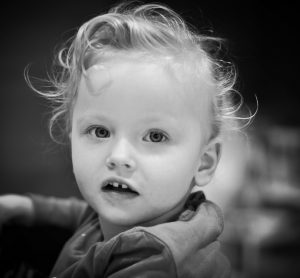 Since my daughter was 1 year and a half, she has attended a specialized care center where she has received all kinds of therapies (speech therapy, physiotherapy, ergotherapy, etc.). We also have a psychologist who comes twice a week for a session of occupational therapy whose main goal is to teach Lisa to use pictograms to communicate with us.
Since my daughter was 1 year and a half, she has attended a specialized care center where she has received all kinds of therapies (speech therapy, physiotherapy, ergotherapy, etc.). We also have a psychologist who comes twice a week for a session of occupational therapy whose main goal is to teach Lisa to use pictograms to communicate with us.
Lisa has an older brother, Thomas, who is now almost 11 years old and behaves very well with her. She is the sunshine of the family and want to do everything possible so that she can be as autonomous as possible.
We are pleased to know that Dr. Stuart Lipton is doing his best to market a medicine that could activate the second copy of the gene MEF2C and thus improve the lives of our children, and ours too. Hopefully we can raise the money needed for these studies.
LAURA
Laura was born on November 3, 2009, in Toledo. Until she was five months she was a baby like everyone else. From that age we began to notice that something was wrong. Laura couldn´t sit, she couldn´t maintain herself erect, she couldn´t fix her gaze, she couldn´t hold anything in her hands, she never cried and especially, she didn´t show any interest in her surroundings. Only music and gleaming toys drew her attention.
We consulted the pediatrician and she told us not to worry, she said each child follows his own evolution, but considering our insistence Laura was made a cranial ultrasound before the closure of the fontanelle. That ultrasound did not show any abnormality and reinforced the theory that they were just “parent issues”.
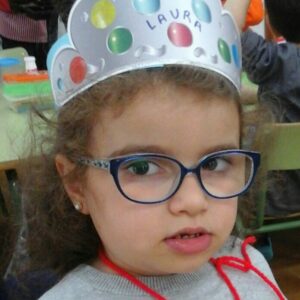 Everything changed in the check-up of nine months, a new pediatrician told us that the child had a severe neurological disease and needed to be urgently sent to Neuro-pediatrics. 20 minutes later we had the first diagnosis: “Rett Syndrome”. We collapsed.
Everything changed in the check-up of nine months, a new pediatrician told us that the child had a severe neurological disease and needed to be urgently sent to Neuro-pediatrics. 20 minutes later we had the first diagnosis: “Rett Syndrome”. We collapsed.
Laura immediately began rehabilitation with several sessions of physiotherapy and Early Stimulation with very slow progress.
Later, they began genetic tests to confirm Rett syndrome, but they were negative. Then it came a tour of possible syndromes. Now, six years later, Laura has a definite diagnosis: “a mutation in the gene MEF2C “.
Three days before her first birthday, Laura had her first crisis. She was admitted to the ICU since it was a long crisis. This was followed by other crisis, all of them with fever. She took several medications to palliate them (first Depakine and then Keppra), but these crisis haven´t returned for four years and she hasn´t taken that medication fot three years.
Today she goes to school and divides her time between CEIP Garcilaso de la Vega of Toledo and the Center for Special Education APAC, both in Toledo. She also receives physiotherapy, speech therapy and therapeutic pool.
Laura walks with difficulty and has stereotyped movements. She cannot control her sphincters, has not developed language but expresses in her own way and despite her intellectual retardation, she perfectly knows what she wants and what she likes. She is starting to use pictograms.
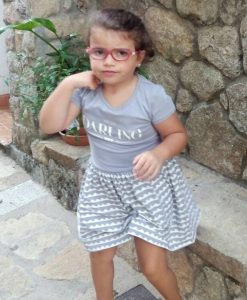 Laura is very affectionate, she likes being hugged and having someone to play with her keeping a very close contact.
Laura is very affectionate, she likes being hugged and having someone to play with her keeping a very close contact.
She likes walking and travelling by car very much and loves watching cartoons on TV, on the tablet and on the mobile. She is passionate about food and eats everything but sweets, which she doesn´t like at all.
We think she is a happy girl. She is very good and loved. Her two older brothers (aged 21 and 16) feel passion for her and we, her parents, are very proud of our family.
With the diagnosis of mutation in the gene MEF2C we have known this Association and their families. This opens a new stage in which we can share experiences, fight for our children together and look forward with hope.
ALICIA
Alicia was born on July 25, 2013 in Barcelona. She has two older brothers, Abril (9) and Aleix (7).
Being our third daughter, we soon realized that she wasn’t evolving as she should, especially because she was not attentive to her surroundings, she did not smile, she was not interested in toys … She started with early stimulation and although very slowly and with much work,she was advancing.
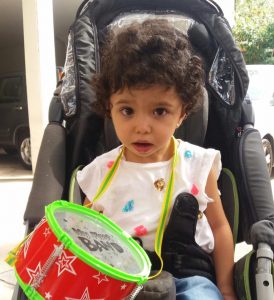 She was done many tests but nothing conclusive came out; At 18 months they began to suspect that she had a mitochondrial disease. Those days she had an epileptic crisis and we began to treat her both for epilepsy and with vitamins for the mitochondria.
She was done many tests but nothing conclusive came out; At 18 months they began to suspect that she had a mitochondrial disease. Those days she had an epileptic crisis and we began to treat her both for epilepsy and with vitamins for the mitochondria.
After a year and a half and discarding all known mitochondria, they diagnosed a deletion in 5q 14.3 with involvement of the genes RASA1 and MEF2C.
With epilepsy medication she has not had more crisis, in general she has been a healthy girl catching the typical viruses and bacteria that all pre-schoo children catch.
During these 3 years Alícia has taken part in many therapies (physiotherapy, speech therapy, hydrotherapy, osteopathy …) during which we have discovered lots of charming and involved professionals who have helped us a lot to understand the girl and to help her to move forward.
Alicia currently attends a special education nursery (CAE “Les Girafes Blaves”) where she performs all sessions of stimulation, physiotherapy … and where we have been taught to make the best of her and the family are given all the support. She also attends swimming sessions, horse therapy and music therapy (which she loves).
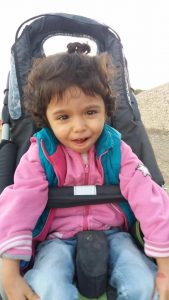 As for her evolution,it is being very slow but little by little she is connecting with her surroundings and is advancing a little.. Alicia does not walk or crawl, she has been able to stay sitting and turn around since she was one. She has some stereotyped movements, she does not speak but she makes herself understood and little by little she has told us what she wants and what she likes. She is starting to use pictograms, she loves the ipad, the swings and the musical toys.
As for her evolution,it is being very slow but little by little she is connecting with her surroundings and is advancing a little.. Alicia does not walk or crawl, she has been able to stay sitting and turn around since she was one. She has some stereotyped movements, she does not speak but she makes herself understood and little by little she has told us what she wants and what she likes. She is starting to use pictograms, she loves the ipad, the swings and the musical toys.
She is a very nice and very affectionate girl with whom we can go everywhere following her older brothers (she loves party) and she has the whole family and friends captivated. The truth is that we are very lucky to have an environment and a family that supports us very much and gives us strength and energy to help Alicia reach the maximum she can.
It has been a great luck that this association exists since it has allowed us to obtain information on this subject and meet people in our same situation so we can share experiences with them. Knowing that someone is investigating these issues gives us hope to continue fighting for the better quality of life of our daughter.
